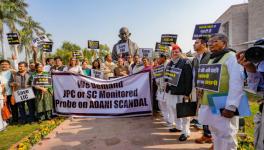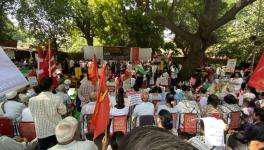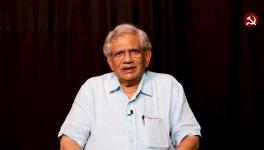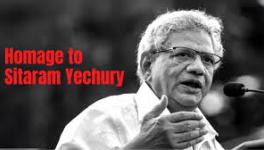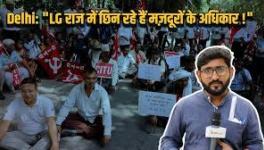Are the Guns Really Falling Silent in the Northeast?
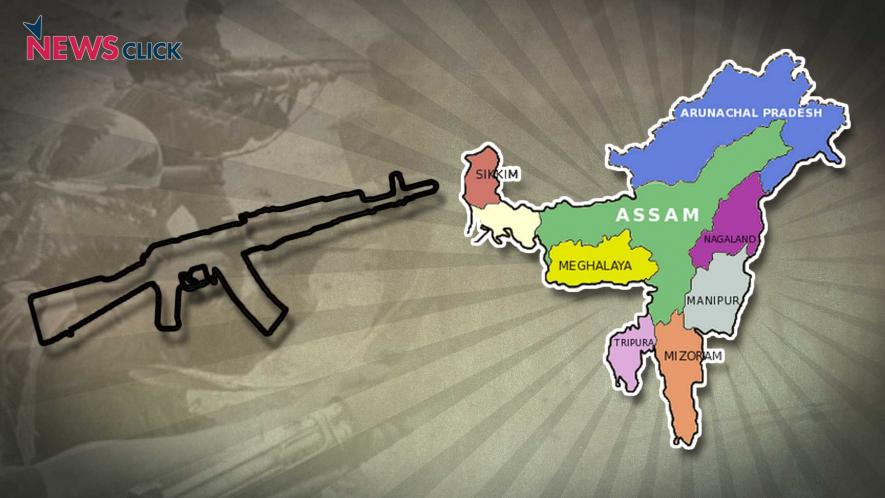
Newsclick Image by Nitesh Kumar
The Northeast has been relatively peaceful this year prompting Union Home Minister Rajnath Singh on December 8 to state that “75 to 80% of the insurgency problems in the northeast has come to an end.” As if to make up for a relatively quiet year, by December 12, the United Liberation Front for Asom (Independent) (ULFA(I)) had already carried out two attacks, one on the manager of a tea estate who refused to pay the Rs 40 Lakh demanded by the Paresh Baruah faction on December 8, and the other a father-son duo on December 11. The father was the head of a Village Defense Council (VDC) and the son a local member of All Assam Students Union (AASU).
Assam has a strange relationship with ULFA, an unnamed source once remarked that ‘in Upper Assam, there is not one family that does not have a relative who served or is serving in ULFA’. At present, Naba Kumar Sarania, a serving elected Lok Sabha MP from Kokrajhar was once known as ‘Hira Sarania’, the commander of the 709 battalion of ULFA. In 2017, the total number of fatalities due to the insurgency in Assam (till December 3) according to the South Asian Terrorism Portal (SATP) was 20, a great reduction from 86 in 2016. The year, however, began with a series of 7 bomb blasts on January 26. There were no fatalities from the blasts and they were mostly limited to Upper Assam and near the Nagaland border. Data on SATP shows that at present there are six active terrorist and insurgent groups in Assam, Communist Party of India-Maoist (CPI-Maoist), Harkat-ul-Mujahideen (HuM), Jama’atul Mujahideen Bangladesh (JMB), IK Songbijit faction of National Democratic Front of Bodoland (NDFB-IKS), Muslim United Liberation Tigers of Assam (MULTA), and United Liberation Front of Asom-Independent (ULFA-I).
Manipur, on the other hand, is witnessing an increase in insurgency-related violence with 55 fatalities as of December 3, compared to 33 in 2016, which saw a major plunge from 94 in 2015. In October 2016, the then Chief Minister of Manipur, Okram Ibobi Singh, narrowly escaped an attack which injured a Manipur Rifles Jawan when unknown assailants opened fire on his helicopter in Ukhrul district. Though no attempts on such high-level targets have occurred in 2017, there were 34 bomb blasts in 2017, with at least one occurring every month till December. The blasts this year have claimed the lives of 6 people and injured 62. According to SATP there are six active insurgent or terrorist groups operating in Manipur, Coordination Committee (CorCom) which is an organization comprising of six valley based groups, Manipur Naga Revolutionary Front (MNRF), National Socialist Council of Nagaland -Isak-Muivah (NSCN-IM), Nationalist Socialist Council of Nagaland-Khaplang (NSCN-K), People's United Liberation Front (PULF), and Zeliangrong United Front (ZUF).
Meghalaya has seen a steady decline in terror or insurgency-related fatalities since 2014. There were 76 fatalities in 2014 which dipped to 61 in 2015, 26 in 2016, and 8 as of December 3, 2017. On the December 4, two members of the Garo National Liberation Army (GNLA) surrendered in the South Garo Hills. Meghalaya had seen a spike in armed violence after the creation of the GNLA in 2010. At present there are eight active terror or insurgent groups in Meghalaya, Achik National Liberation Army (ANLA), Achick Songa An'pachakgipa Kotok (ASAK), Achik National Liberation Co-operative Army (ANLCA), Achik Tiger Force (ATF), Achik National United Force (ANUF), Hynniewtrep National Liberation Council (HNLC), Liberation of Achik Elite Force (LAEF), and the Garo National Liberation Army (GNLA).
Nagaland has seen the greatest drop in insurgency or terrorism-related fatalities, though the number in 2017 is an increase as compared to 2016, it is nowhere near the 1997 level before the talks between the Government of India and the National Socialist Council for Nagaland Isak Muivah NSCN(IM) began. There were 8 fatalities in 2017 as compared to 6 in 2016 and 360 in 1997. At present there are five active insurgent or terrorist groups in Nagaland, Federal Government of Nagaland-Non-Accordist (FGN-NA), Federal Government of Nagaland -Accordist (FGN-A), Non-Accordist faction of Naga National Council (NNC-NA), Naga National Council-Accordist (NNC-Accordist), and the National Socialist Council of Nagaland (Khaplang) – NSCN (K).
Arunachal Pradesh has witnessed exchange of small-arms fire in its eastern most districts of Tirap, Changlang and Longding (TLC) between security forces (SFs) and members of insurgent groups from other states, like ULFA(I), NSCN(IM), and NSCN(K). Due to the thick jungle cover along the border with Myanmar, Arunachal Pradesh has become a transit route for insurgent groups in the Northeast. The TLC districts also form a part of the NSCN’s view of a united ‘Nagalim’. Though non-Naga tribes in these districts are not happy about it.
Mizoram, Sikkim, and Tripura are the only states in the Northeast that have not witnessed any terrorism or insurgency-related deaths in 2017. Tripura has seen no insurgency or terrorism-related deaths since 2015, and Mizoram since 2016. Neither of these states has any active insurgent or terrorist groups.
Assam, Manipur and Nagaland have witnessed violence largely due to the creation of the United National Liberation Front of Western South East Asia (UNLFW). The UNLFW was created on April 17, 2015, as an amalgamation of four insurgent groups, NSCN(K), ULFA(I), Kamatapur Liberation Organisation (KLO), and NDFB(S). The group is responsible for multiple attacks on SFs operating in the Northeast. The group had slowed its activities after the death of its chairman S. S. Khaplang who was also the leader of the NSCN(K) on June 9, 2017. Khango Konyak was later declared the Khaplang’s successor of the NSCN(K), and later the UNLFW. In Manipur, CorCom which was not operationally affected by Khaplang’s demise continued attacking SFs with IEDs. With the renewed extortion notices being served by ULFA(I), and the succession of NSCN(K) and UNLFW complete, there may be a spike in violence in the Northeast in 2018. The signing of the Framework Agreement between the NSCN(IM) and the Government of India has yet to see fruition, and the Nagas in Nagaland are anxiously waiting for a final agreement to be reached. The final agreement may prove to be the game changer regarding insurgency in the Northeast with the former militants of NSCN(IM) supporting the SFs in checking insurgent flows. However, the danger of no deal in the near future may push the NSCN(IM), or sections of it, back to the path of war.
Get the latest reports & analysis with people's perspective on Protests, movements & deep analytical videos, discussions of the current affairs in your Telegram app. Subscribe to NewsClick's Telegram channel & get Real-Time updates on stories, as they get published on our website.










